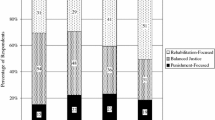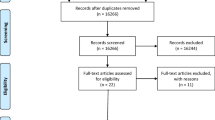Abstract
Mental health courts (MHCs) represent an important new development at the interface of the criminal justice and mental health systems. MHCs are criminal courts for persons with mental illness that were in part created to divert this population from jail/prison into community treatment. MHCs are proliferating rapidly despite limited knowledge regarding their characteristics or their efficacy. We surveyed the entire population of adult MHCs in the United States, n=90. In the past 8 years, MHCs have been created in 34 states, with an aggregate current caseload of 7,560 clients in MHCs nationally. Most courts (92%) reported using jail as a sanction for noncompliance, if only rarely. Further, jail sanction use was significantly predicted by increased judicial supervision and number of felons in the court. Implications for MHCs and social monitoring are discussed.

Similar content being viewed by others
Notes
Judicial supervision (lower scores indicate more frequent supervision) and community supervision (higher scores indicate more forms of supervision) were significantly correlated, r=−.23, p=.03. Thus, it is possible, in the regression predicting jail sanction use, the two forms of supervision did not provide unique variance.
References
Bazelon Center for Mental Health Law (2003). Criminalization of people with mental illnesses: The role of mental courts in system reform. Jail Suicide/Mental Health Update, 12, 1–8, 10–11.
Boothroyd, R., Calkins Mercado, C., Poythress, N. P., Christy, A., & Petrila, J. (2005). After mental health court: Do diverted defendants experience improved clinical outcomes. Psychiatric Services, 56, 829–834.
Casey, T. (2005). When good intentions are not good enough: Problem-solving courts and the impending crisis of legitimacy. SMU Law Review, 57, 1459–1519.
Clark, R. E., Ricketts, S. K., & McHugo, G. J. (1999). Legal system involvement and costs for persons in treatment for severe mental illness and substance use disorders. Psychiatric Services, 50, 641–647.
CMHS. (1995). Double jeopardy: Persons with mental illnesses in the criminal justice system. A report to Congress. Rockville, MD: U.S. Department of Health and Human Services, Substance Abuse and Mental Health Services Administration, Center for Mental Health Services.
Cosden, M., Ellens, J., Schnell, J., Yasmeen, Y., & Wolfe, M. (2003). Evaluation of a mental health treatment court with assertive community treatment. Behavioral Sciences and the Law, 21, 427–427.
Council of State Governments. (2002). Criminal justice/mental health consensus project. Retrieved October 10, 2002, from http://www.consensusproject.org.
Draine, J., & Solomon, P. (1999). Describing and evaluating jail diversion services for persons with serious mental illness. Psychiatric Services, 50, 56–61.
GAINS Center for People with Co-Occurring Disorders in the Justice System. (2005). Survey of mental health courts. Delmar, NY. Available online at http://www.mentalhealthcourtsurvey.com/
Goldkamp, J. D., & Irons-Guynn, C. (2000). Emerging judicial strategies for the mentally ill in the criminal caseload: Mental health courts in Fort Lauderdale, Seattle, San Bernardino, and Anchorage. Washington, DC: U.S. Department of Justice, Office of Justice Programs, Bureau of Justice Assistance Monograph, pub. no. NCJ 182504.
Gottfredson, M. R., Mitchell-Herzfeld, S. D., & Flanagan, T. J. (1982). Another look at the effectiveness of parole supervision. Journal of Research in Crime and Delinquency, 19, 277–298.
Griffin, P., Steadman, H. J., & Petrila, J. (2002). The use of criminal charges and sanctions in mental health courts. Psychiatric Services, 53, 1285–1289.
Herinckx, H. A., Swart, S. C., Ama, S. M., Dolezal, C. D., & King, S. (2005). Rearrest and linkage to mental health services among clients of the Clark County mental health court program. Psychiatric Services, 56, 853–857.
Naples, M., & Steadman, H. J. (2003). Can persons with co-occurring disorders and violent charges be successfully diverted? International Journal of Forensic Mental Health, 2, 137–143.
National Drug Court Institute. (June 2000). The critical need for jail as a sanction in the drug court model. Drug Court Practitioner Fact Sheet, 2. Alexandria, VA. Available online at http://www.nadcp.org/publications/
Peters, R. H., & Hills, H. A. (1993). Inmates with co-occurring substance abuse and mental health disorders. In H. Steadman & J. Cocozza (Eds.), Mental illness in America’s prisons. Seattle, WA: National Coalition for the Mentally Ill in the Criminal Justice System.
Petrila, J. (2003). An introduction to special jurisdiction courts. International Journal of Law and Psychiatry, 26, 3–12.
Public Law 106-515, America’s Law Enforcement and Mental Health Project (Nov. 13, 2000; 114 Stat. 2399).
Redlich, A. D. (2005). Voluntary, but knowing and intelligent? Comprehension in mental health courts. Psychology, Public Policy, and Law, 11, 605–619.
Redlich, A. D., Steadman, H. J., Monahan, J., Petrila, J., & Griffin, P. (2005). Thesecond generation of mental health courts. Psychology, Public Policy, and Law, 11, 527–538.
Seltzer, T. (2005). Mental health courts: A misguided attempt to address the criminal justice system’s unfair treatment of people with mental illnesses. Psychology, Public Policy, and Law, 11, 570–586.
Solomon, P., & Draine, J. (1995). One-year outcomes of a randomized trial of case management with seriously mentally ill clients leaving jail. Evaluation Review, 19, 256–273.
Solomon, P., Draine, J., & Marcus, S. C. (2002). Predicting incarceration of clients of a psychiatric probation and parole service. Psychiatric Services, 53, 50–56.
Solomon, P., Draine, J., & Meyerson, A. (1994). Jail recidivism and receipt of community mental health services. Hospital and Community Psychiatry, 45, 793–797.
Steadman, H., Davidson, S., and Brown, C. (2001). Mental health courts: Their promise and unanswered questions. Psychiatric Services, 52, 457–458.
Steadman, H. J., Fabisiak, S., Dvoskin, J., & Holohean, E. J. (1987). A survey of mental disability among state prison inmates. Hospital and Community Psychiatry, 38, 1086–1090.
Steadman, H. J., Morris, S. M., & Dennis, D. L. (1995). The diversion of mentally ill persons from jails to community-based services: A profile of programs. American Journal of Public Health, 85, 1630–1635.
Steadman, H. J., Redlich, A. D., Griffin, P., Petrila, J., & Monahan, J. (2005). From referral to disposition: Case processing in seven mental health courts. Behavioral Sciences and the Law, 23, 1–12.
Tonry, M. (1990). Stated and latent functions of ISP. Crime and Delinquency, 36, 174–191.
Torrey, E. F., Stieber, J., Ezekiel, J., Wolfe, S. M., Sharfstein, J., Noble, J. H., et al. (1992). Criminalizing the mentally ill: The abuse of jails as mental hospitals. Washington, DC: Public citizen’s health research group.
Trupin, E., & Richards, H. (2003). Seattle’s mental health courts: Early indicators of effectiveness. International Journal of Law and Psychiatry, 26, 33–53.
Winick, B. J., & Wexler, D. B. (2003). Judging in a therapeutic key: Therapeutic jurisprudence and the courts. Durham, NC: Carolina Academic Press.
Acknowledgments
This study was funded by the National Institute of Justice (Grant #2003-DD-BX-1012) and the John D. and Catherine T. MacArthur Foundation. We are grateful to Aubrey Spaulding and Margaret Eck-Raider for their help with data collection.
Author information
Authors and Affiliations
Corresponding author
Appendix
Appendix

About this article
Cite this article
Redlich, A.D., Steadman, H.J., Monahan, J. et al. Patterns of Practice in Mental Health Courts: A National Survey. Law Hum Behav 30, 347–362 (2006). https://doi.org/10.1007/s10979-006-9036-x
Published:
Issue Date:
DOI: https://doi.org/10.1007/s10979-006-9036-x




